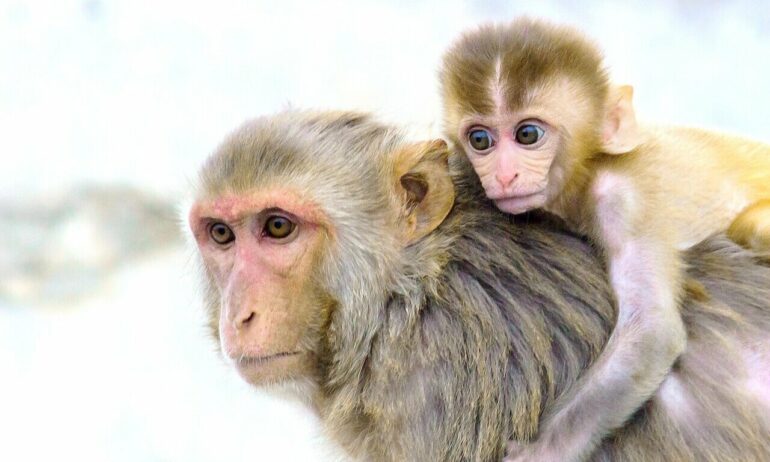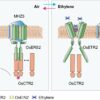What’s the link between social life and brain structure? Researchers from the University of Pennsylvania, the Stem Cell and Brain Research Institute at Inserm, and elsewhere are now one step closer to understanding this connection for rhesus macaques.
In work published in Science Advances, the team found that for these nonhuman primates the number of social connections predicted the size of key nodes in parts of the brain responsible for social decision-making and empathy. Specifically, the researchers determined that, for macaques with more grooming partners, the mid–superior temporal sulcus (STS) and ventral-dysgranular insula grew larger. They found no such link between brain structure and other variables like social status.
“For the first time, we’re able to relate the complexity of social lives of a group of living primates with brain structure,” says Camille Testard, a fourth-year doctoral student in the Platt Labs at Penn and lead author of the paper.
Previous research on human social networks has hinted at this relationship, says Michael Platt, the James S. Riepe Penn Integrates Knowledge University Professor. “The literature, for example, ties variation in the size of the amygdala to the number of Facebook friends that you have. But it’s hard to get granular data on human social interactions because we can’t follow people around all day long,” he says.
With the rhesus macaques living on Cayo Santiago, an island off the coast of Puerto Rico, however, it’s a different story. Platt and colleagues have studied this group of free-ranging nonhuman primates for more than a decade. Part of that research has focused on grooming partners, which represent direct and important relationships for the macaques, as well as looking at the animals’ broader social networks, representing individuals they interact with indirectly.
After Hurricane Maria hit the island, for example, the researchers examined whether the macaques grew or shrunk their social networks in the face of more limited resources. Testard, who joined the lab in 2018, led the analysis for that study, which found that the animals became more social and more accepting of one another, forming new relationships in addition to those they already had.
Building on that and on previous work from collaborator Jérôme Sallet of Inserm, Testard also designed the current study. Here, the team recorded the detailed interactions of a social group of 68 adult rhesus macaques on Cayo Santiago, then examined five factors: social status, number of grooming partners, physical distance with other monkeys, connectedness to popular monkeys in the network, and what the researchers called “betweenness,” or the ability to act as a bridge between disconnected parts of the social network. They also collected brain scans for every individual in the social group, including 35 juvenile and infant macaques.
Analyzing the adult data, Testard and colleagues discovered that the more grooming partners individuals had, the larger their mid-STS and ventral-dysgranular insula were. “It was very interesting to find these regions, as their importance is known for social cognition in humans,” Sallet says. “We also identified the mid-STS region in another study showing that activity in this region is modulated by the predictability of others’ behaviors.”
One unexpected finding centered around the infants. According to Testard and colleagues, the work showed that young macaques weren’t born with these differences in brain structure but, rather, the differences arose with development.
“There’s something about the skills it takes to make and maintain a lot of friendships that you get from parents. You’d think it would be written into your brain when you’re born, but it seems more likely to emerge from the patterns and interactions that you have,” Platt says. “Perhaps that means that if your mother is social and you’ve got the capacity to be social, your brain can mature in the way that looks like the findings we’ve uncovered. That’s intriguing.”
This negative result is telling, Sallet says. “If we had seen the same correlation, it could mean that if you are born from a very popular mother then somehow you have a brain that predisposes you to become more popular later in life. Instead, what I think it suggests is that the modulation we observe is strongly driven by our social environments, maybe more than by our innate predisposition.”
Though all these findings relate specifically to free-ranging rhesus macaques, they have possible implications for human behavior, in particular to understanding neurodevelopmental disorders like autism, according to Platt.
Such connections, however, are still in the distance. For now, the team is moving ahead with additional research studying Cayo Santiago’s population of macaques, looking at facets like whether a natural disaster such as Hurricane Maria affects the animals’ brain structure and how social connectedness influences long-term survival. They’ll continue to dive deeper into their most recent findings, too.
“This is not some lab phenomenon. This is real life, the real world,” Platt says. “This work provides a baseline for understanding how these animals navigate. It’s really thrilling and gratifying that this work done in the field is synergizing work we’ve been doing in the lab for a long time.”
More information:
Camille Testard et al, Social connections predict brain structure in a multidimensional free-ranging primate society, Science Advances (2022). DOI: 10.1126/sciadv.abl5794. www.science.org/doi/10.1126/sciadv.abl5794
Provided by
University of Pennsylvania
Citation:
Social connections influence brain structure of rhesus macaques (2022, April 13)



